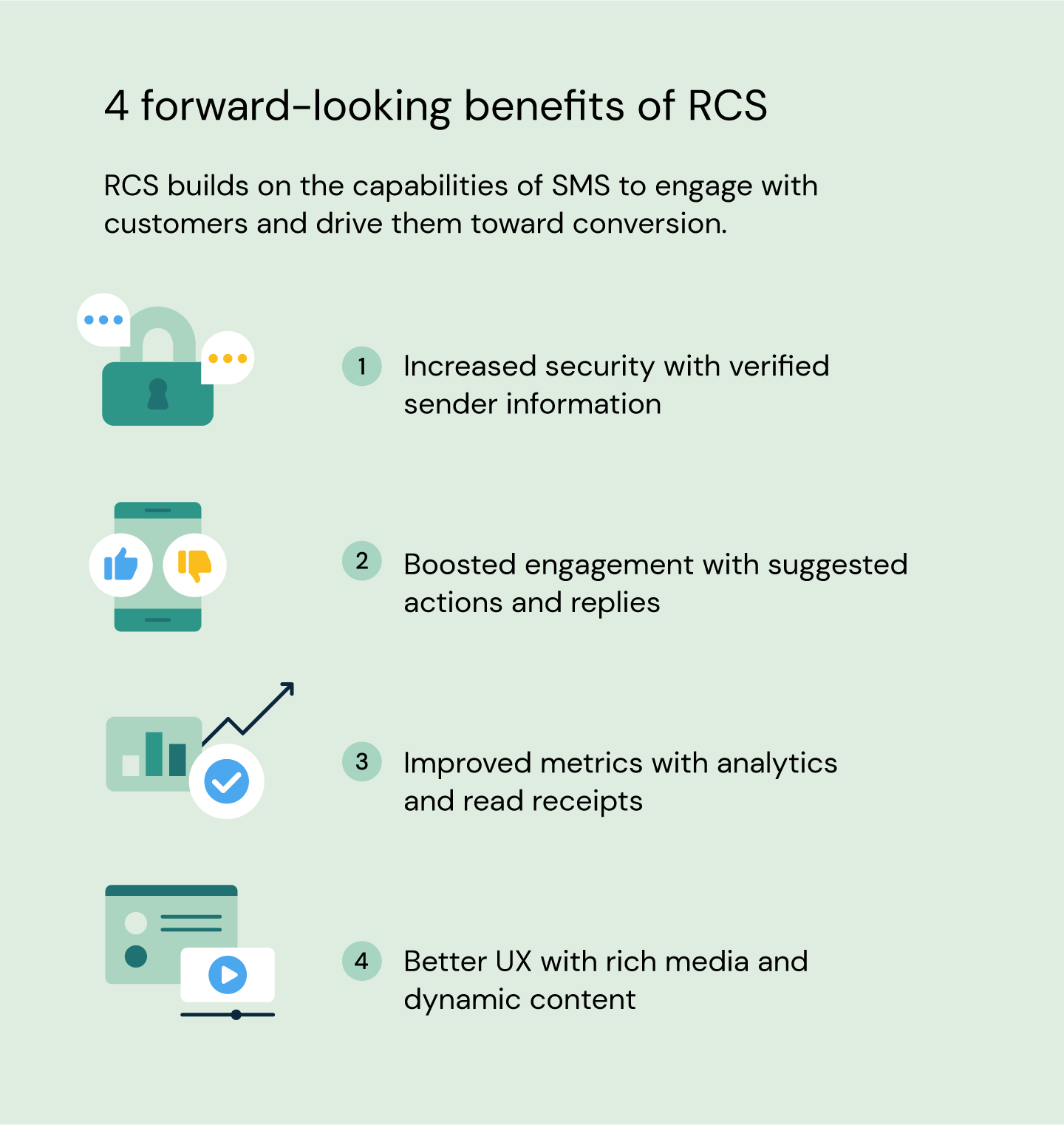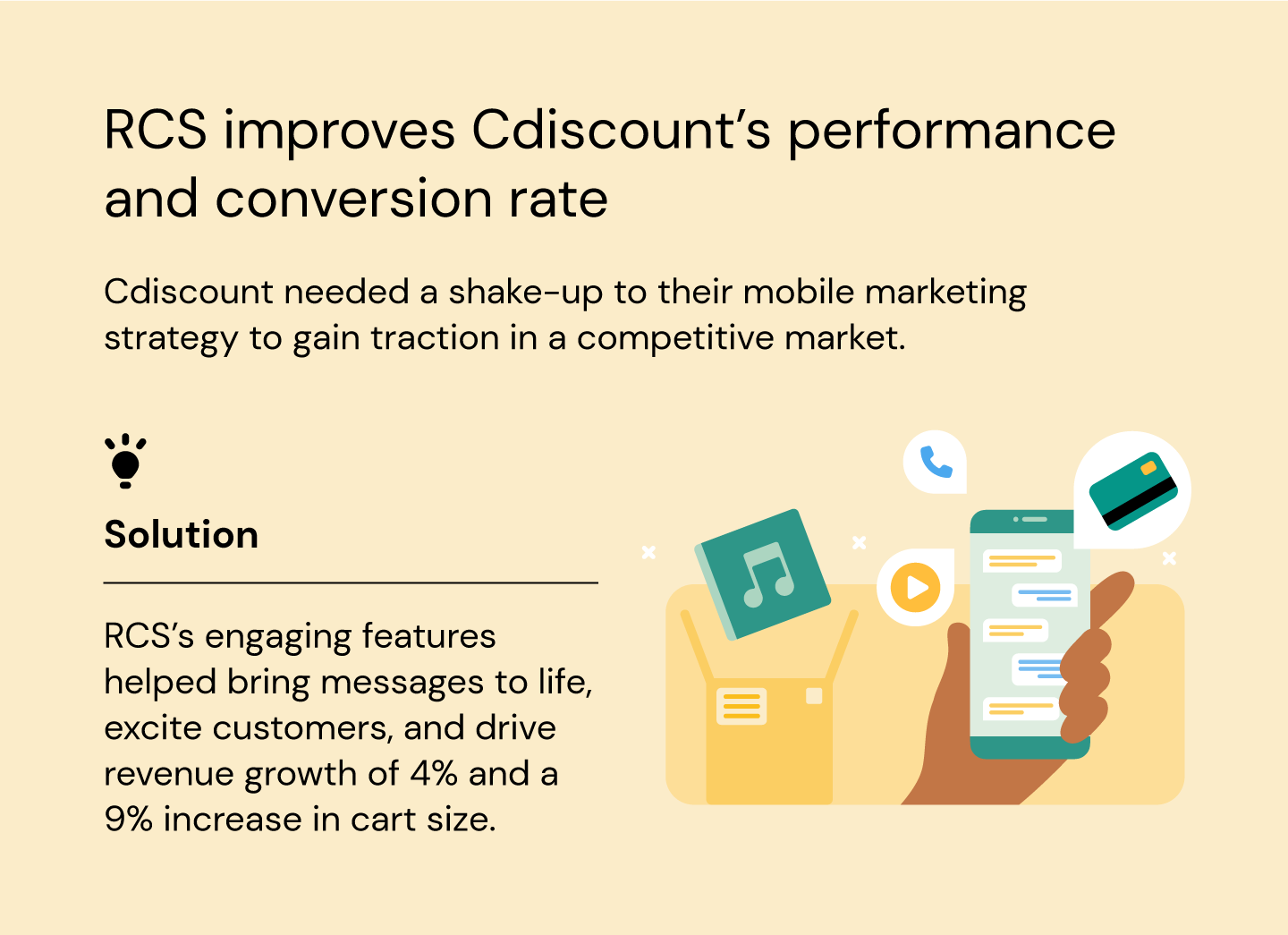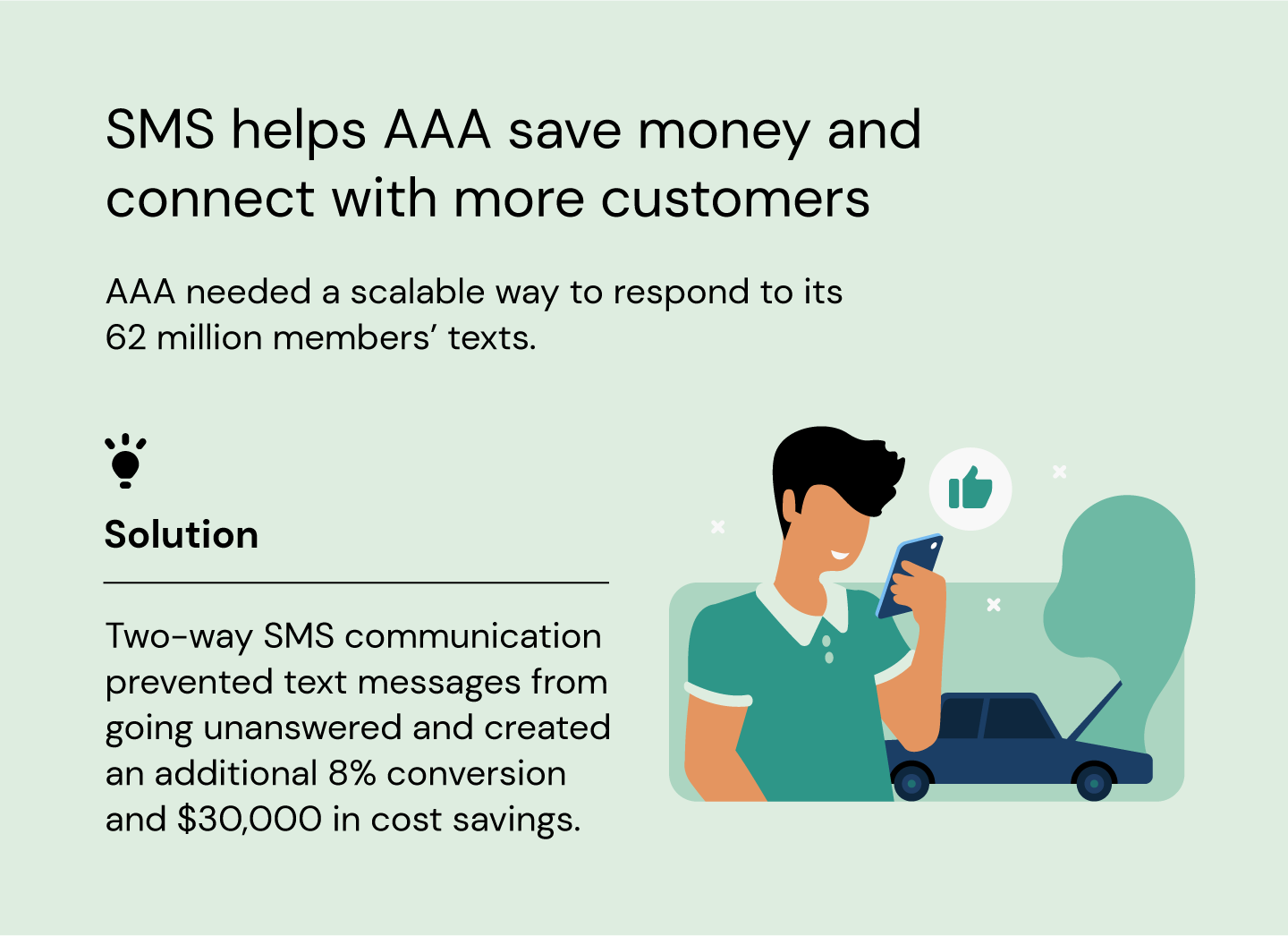“Merry Christmas.” More than 30 years ago, that was the content of the very first short messaging service (SMS) message. Almost immediately after, the new and ingenious invention was implemented into mobile phones by manufacturers around the world. End users loved its quick and effective performance, and it was easy to use.
Fast forward to today and much has changed in the world of mobile messaging, including the introduction of Rich Communication Services (RCS). RCS messaging enables enterprises and brands to connect with users via large, high-quality snippets and attachments on Android phones, while SMS has less functionality but wider device capability.
SMS established itself as the mobile messaging technology of choice some time ago, but RCS can augment SMS’s more limited features. As business communication continues to evolve, RCS will become more important as a complement to an SMS marketing strategy. Let’s dive a little deeper into the benefits of both SMS and RCS, and how they can help you engage with your customers effectively, if a little differently.
SMS: The standard - for now
SMS is the most established and widest-used form of texting. It’s considered the default messaging type worldwide. Because it’s so common, you can use SMS to reach almost any user without them being connected to a WiFi or data network to receive a message. It also serves as a fallback option when messages over other channels don’t get delivered.
SMS can be conversational, but not with the capabilities of RCS. Users can reply to messages and engage in limited ways, such as replying with a short code or a trigger word.
Short messages are familiar; more than 23 billion SMS texts are sent daily from one person to another. SMS is so prevalent that over time, it might not show more significant growth. However, because of its reach, it’ll continue to have an important place in a multifaceted communication strategy.
RCS: What it is and why it’s the future
The RCS messaging protocol is an advanced service that upgrades the messaging experience for Android users, creating a better experience and functioning more like an OTT app like iMessage or WhatsApp than SMS.
However, the difference with RCS is that users can use it right within their phone’s native messaging app. This means that users can access the more modern features of RCS – like real-time, branded messages, high-resolution video, read receipts, group chats, typing indicators, end-to-end encryption, and more – without having to download a new third-party app.
These features make rich communications so powerful, potentially explaining why RCS users are more engaged than SMS users. In fact, those who receive messages on the richer channel are more likely to interact and convert to paying customers.

RCS builds on the messaging capabilities of SMS so brands can drive customers toward conversion.
Key features and characteristics of RCS
RCS gives brands the opportunity to send high-quality, multimedia content to guide users through their conversations. These feature-rich messages are received either via WiFi or an operator's cellular data connection (4G, 5G), unlike SMS which is carried by signaling. RCS business messages function to boost customer engagement, with features such as:
- Rich cards
- Suggested replies
- Suggested actions
Rich cards
Rich cards are an RCS capability that allows you to send a batch of information to a user. Rich cards far surpass SMS capabilities because they can contain media, text, and even suggested replies and actions for your users, supporting these formats:
- JPG
- PNG
- Video
- Audio
- GIFs
Rich cards can be sent standalone or grouped together into an entire 'carousel' which enables many options to be presented to the recipient at once.
Suggested replies
Suggested replies are a helpful tool to guide users through your conversation and keep them engaged. These suggestions are next steps that the user can use to quickly respond, relevant within the context of the chat. They’re either sent in the form of lists (sometimes known as suggestion chips or buttons) or within rich cards.
Suggested actions
While suggested replies help push your conversation forward, suggested actions take it up a notch. Actions leverage the user’s device and its functionality for a better customer experience. They’re buttons users can click to accomplish a host of tasks, like:
-
Opening a webpage
-
Calling customer support
-
Finding a destination on a map
Suggested actions have lots of capabilities, so it’s important to make sure part of your conversational messaging strategy is to avoid inundating your users with too many options.
Compare RCS vs SMS
As a subscriber, receiving an RCS message vs SMS message can be quite different. For one, SMS messages are sent over the cellular network, while RCS content requires data connectivity, so they’d have to have a device with mobile data capabilities or an internet connection. Some other key differences come down to reach, media capabilities, and branding opportunities. Take a look at this chart for an easy comparison of SMS vs RCS!
|
|
RCS |
SMS |
|
Usability |
No app to download; found in the native messaging app on an Android user’s mobile device. |
No app to download; found in the native messaging app on a user’s mobile device (including both Androids and iPhones). |
|
Reach |
One billion active Android users. |
100% of mobile phone users on the planet (approx. 7.3 billion people). |
|
Text capabilities |
No character limit on RCS messages.
|
Send up to 160 characters in a single message. |
|
Media capabilities |
Rich cards with media, text, and even suggested replies and actions for your users, supporting JPG, PNG, video, and audio. |
No images or suggested actions can be included (but you can send images and links in MMS messages). |
|
User experience |
Offers features like interactive buttons and quick-reply buttons. |
Offers text chat features. |
|
Engagement |
Very high – 90% of rich media messages are opened within 15 minutes, and customers engage with RCS content for up to 45 seconds. |
Very high – historically has had an open rate of over 90%. |
|
Branding opportunities |
All messages include a brand logo and verified sender information. |
Some countries allow for Alpha Sender IDs. Only available in select markets and rules differ about when these can be used. |
What can SMS vs RCS offer your business?
Depending on your customers’ needs and preferences, both RCS and SMS might suit your business. Many businesses combine RCS and SMS as part of their broader messaging strategy to cover all their bases.
While SMS is a reliable option for basic text messages up to 160 characters, RCS chat offers enhanced features and the ability to send longer messages to your audience with Android devices.
That could be why so many businesses that want to embrace a rich messaging future start with an easy solution: Auto-upgrading existing SMS messages to RCS where it’s possible and maintaining SMS where needed. Embracing this business messaging strategy at your business ensures that you’re catering to the widest audience possible.
Let’s dive into some specific use cases of businesses using RCS and SMS.
RCS use case - Cdiscount
RCS is a more complete and enticing experience than SMS, which is why RCS users are more likely to be engaged and convert than traditional SMS users. In this way, RCS isn’t replacing SMS, but instead complements it as part of a complete messaging solution.
Retailer Cdiscount needed a way to revitalize its marketing strategy and avoid a situation where revenue flatlined or dropped. They used SMS to communicate with customers but weren’t seeing continued growth, so they looked to RCS to visually enhance their messages and further engage customers.
By expanding its messaging capabilities, Cdiscount saw a 9% increase in cart size and a 4% increase in revenue overall – numbers that indicate how RCS can drive customers to be more engaged and eventually convert.

RCS's engaging features significantly improved Cdiscount’s conversion rate, resulting in measurable increases in revenue!
SMS use case - AAA
The American Automobile Association (AAA) used the reliability and widespread use of SMS to significantly increase its customer support function. AAA found that users were texting its helpline, which wasn’t enabled for text communication – so messages were simply lost and went unanswered.
By implementing a two-way SMS solution - which 89% of people prefer to talking on the phone - AAA was able to respond to text messages with a web link that allowed users to start a claim. This created an additional 8% conversion from SMS out of AAA’s 62 million users and saved AAA $30,000 in soft costs.
Customers choose SMS texting because it’s affordable and scalable, and it converts with as much as a 98% open rate and 19% click through rate.

AAA implemented two-way SMS communication to drive meaningful customer experiences.
Which media and devices support RCS and SMS?
RCS is a collaboration between Google and mobile operators, and although today it’s only supported on Android devices, support is growing all the time. In fact, in June 2024, Apple confirmed that it would support RCS in the iOS 18 update in fall 2024.
Though some of the details are still unclear, this holds the promise of an improved messaging experience for users with both Android and Apple devices.
For now, RCS is most commonly used on Android’s default Google Messages app. You can check if your phone supports RCS within the app by navigating to the settings menu and browsing chat features.
Every mobile device with a network connection supports SMS. This is why SMS and RCS can work in tandem to deliver a more complete messaging solution - everyone with a cell phone is capable of receiving SMS messages so long as they’re connected to a mobile network.
Find a solution no matter your messaging strategy
No matter your goals, there’s a messaging solution that will help your business achieve conversational commerce success. If your needs are more conversational, RCS has expanded capabilities that liven up marketing communications for an enhanced experience. If you primarily need to send notifications like fraud or delivery updates, then an easy-to-integrate SMS API may meet your needs.
Or, if you're ready to get started with RCS, you can download our comprehensive RCS guide which will walk you through how to make the case to bring RCS into your organization.

If you’re ready to implement new messaging channels, let’s chat. Our team is excited to help you build a messaging strategy your customers will love!



